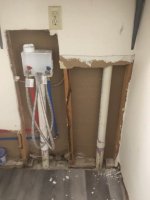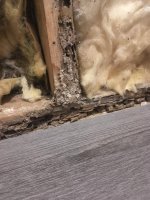Hi there, I live in a garden level condo w/ one unit above us.
We've had years of low-level, vague problems since buying our condo. This includes things such as our clothes carrying a strange stench no matter how much we wash them or how often I cleaned the washing machine. We even bought a new washing machine.
Eventually, we discovered the laundry room was flooding...and based on the look of it once we tore out the walls, it's been going on for years. Seems the washing machine has been backflowing behind the walls...but not a flash flood kind of way and not all the time.
Anyway, thanks to ripping out the walls, I can see now we just have a single pipe to hold the hookups and a 90 degree elbow to the sewer drain. No p-trap and no vent.
What can be done about this? We don't have any other pipe. The unit above us has one pipe as well, and hers was done properly w/ a p-trap and vent to the roof. Ours does not go to the roof. We do not have any legal right to touch her pipe.
What in the world??
We've had years of low-level, vague problems since buying our condo. This includes things such as our clothes carrying a strange stench no matter how much we wash them or how often I cleaned the washing machine. We even bought a new washing machine.
Eventually, we discovered the laundry room was flooding...and based on the look of it once we tore out the walls, it's been going on for years. Seems the washing machine has been backflowing behind the walls...but not a flash flood kind of way and not all the time.
Anyway, thanks to ripping out the walls, I can see now we just have a single pipe to hold the hookups and a 90 degree elbow to the sewer drain. No p-trap and no vent.
What can be done about this? We don't have any other pipe. The unit above us has one pipe as well, and hers was done properly w/ a p-trap and vent to the roof. Ours does not go to the roof. We do not have any legal right to touch her pipe.
What in the world??





